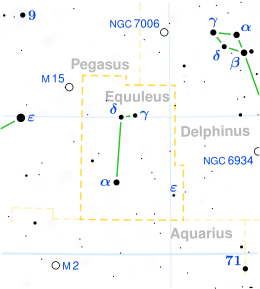Alpha Equulei
Alpha Equulei (α Equulei, abbreviated Alpha Equ, α Equ), officially named Kitalpha /kɪˈtælfə/,[5][6] is a star in the constellation of Equuleus. It is a high proper motion star only 190 light years away.
 | |
| Observation data Epoch J2000.0 Equinox J2000.0 | |
|---|---|
| Constellation | Equuleus |
| Right ascension | 21h 15m 49.43192s[1] |
| Declination | +5° 14′ 52.2430″[1] |
| Apparent magnitude (V) | +3.919[2] |
| Characteristics | |
| Spectral type | G7III + kA3hA4mA9[3] |
| U−B color index | +0.284[2] |
| B−V color index | +0.529[2] |
| Astrometry | |
| Radial velocity (Rv) | −15.71 ± 0.05[3] km/s |
| Proper motion (μ) | RA: +59.88 ± 0.23[1] mas/yr Dec.: −94.09 ± 0.18[1] mas/yr |
| Parallax (π) | 17.14 ± 0.21[1] mas |
| Distance | 190 ± 2 ly (58.3 ± 0.7 pc) |
| Absolute magnitude (MV) | +0.17 (0.71 + 1.18)[3] |
| Orbit[3] | |
| Period (P) | 98.8098 days |
| Eccentricity (e) | 0 |
| Semi-amplitude (K1) (primary) | 16.34 ± 0.07 km/s |
| Semi-amplitude (K2) (secondary) | 17.9 ± 0.3 km/s |
| Details | |
| A | |
| Mass | 2.3[3] M☉ |
| Radius | 9.2[3] R☉ |
| Luminosity | 52.5[3] L☉ |
| Temperature | 5,100[3] K |
| Rotational velocity (v sin i) | 20.0[4] km/s |
| B | |
| Mass | 2.0[3] M☉ |
| Radius | 2.6[3] R☉ |
| Luminosity | 26.3[3] L☉ |
| Temperature | 8.150[3] K |
| Age | 740[3] Myr |
| Other designations | |
| Database references | |
| SIMBAD | data |
Nomenclature
α Equulei (Latinised to Alpha Equulei) is the star's Bayer designation.
It bore the traditional name Kitalpha (rarely Kitel Phard or Kitalphar), a contraction of the Arabic name قطعة الفرس qiṭ‘a(t) al-faras "a piece of the horse". In 2016, the International Astronomical Union organized a Working Group on Star Names (WGSN)[7] to catalogue and standardize proper names for stars. The WGSN approved the name Kitalpha for this star on 21 August 2016 and it is now so entered in the IAU Catalog of Star Names.[6]
In Chinese, 虚宿 (Xū Sù), meaning Emptiness, is an asterism consisting of Alpha Equulei and Beta Aquarii.[8] Consequently, the Chinese name for Alpha Equulei itself is 虛宿二 (Xū Sù èr, English: the Second Star of Emptiness.)[9]
Properties
The overall appearance of α Equulei is a G-type giant[10] with an apparent magnitude of +3.92, but it is a spectroscopic binary consisting of two individual stars.
The primary star is a G7 giant about fifty times more luminous than the sun. It has an effective temperature of 5,100 K and a radius of 9.2 times greater than the sun.
The secondary is an A-type dwarf about 26 times as luminous as the sun. It has an effective temperature of 8,150 K and a radius 2.6 times greater than the sun. It is a chemically peculiar Am star.[3]
The two stars revolve in a circular orbit every 98.8 days. Their respective orbital velocities allow their masses to be calculated at 2.3 M☉ and 2.0 M☉ respectively.[3]
References
- van Leeuwen, F. (2007). "Validation of the new Hipparcos reduction". Astronomy and Astrophysics. 474 (2): 653–664. arXiv:0708.1752. Bibcode:2007A&A...474..653V. doi:10.1051/0004-6361:20078357.Vizier catalog entry
- Cousins, A. W. J. (1984). "Standardization of Broadband Photometry of Equatorial Standards". South African Astronomical Observatory Circulars. 8: 59. Bibcode:1984SAAOC...8...59C.
- Griffin, R. E. M.; Griffin, R. F. (2002). "Composite spectra Paper 11: α Equulei, an astrometric binary with an Am secondary". Monthly Notices of the Royal Astronomical Society. 330 (2): 288. Bibcode:2002MNRAS.330..288G. doi:10.1046/j.1365-8711.2002.05030.x.
- Pizzolato, N.; Maggio, A.; Sciortino, S. (September 2000), "Evolution of X-ray activity of 1-3 Msun late-type stars in early post-main-sequence phases", Astronomy and Astrophysics, 361: 614–628, Bibcode:2000A&A...361..614P
- Kunitzsch, Paul; Smart, Tim (2006). A Dictionary of Modern star Names: A Short Guide to 254 Star Names and Their Derivations (2nd rev. ed.). Cambridge, Massachusetts: Sky Pub. ISBN 978-1-931559-44-7.
- "IAU Catalog of Star Names". Retrieved 28 July 2016.
- IAU Working Group on Star Names (WGSN), International Astronomical Union, retrieved 22 May 2016.
- (in Chinese) 中國星座神話, written by 陳久金. Published by 台灣書房出版有限公司, 2005, ISBN 978-986-7332-25-7.
- (in Chinese) 香港太空館 - 研究資源 - 亮星中英對照表 Archived 2011-01-29 at the Wayback Machine, Hong Kong Space Museum. Accessed on line November 23, 2010.
- Ginestet, N.; Carquillat, J. M.; Jaschek, C. (1999). "Spectral classifications in the near infrared of stars with composite spectra. III. Study of a sample of 137 objects with the Aurelie spectrograph". Astronomy and Astrophysics Supplement. 134 (3): 473. Bibcode:1999A&AS..134..473G. doi:10.1051/aas:1999444.